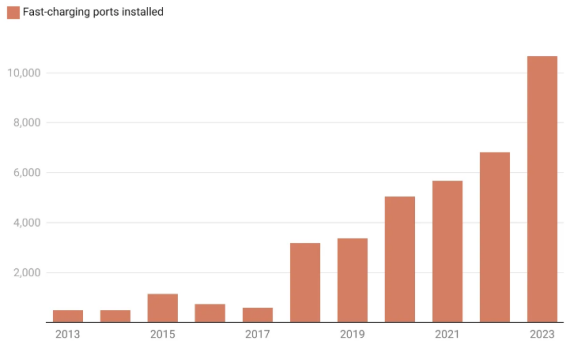
What The Science Says:
The majority of EVs can travel roughly 200 miles on a single charge and some models can travel over 400 miles on a single charge, more than enough to meet the daily needs of median U.S. households.
Climate Myth: Electric vehicles are impractical due to range restrictions
"Here’s the problem with an electric car: they don’t go far. Very simple." (Donald Trump on CSPAN)
The majority of EVs can travel roughly 200 miles on a single charge and some models can travel over 400 miles on a single charge.1,2,3 Although the median range of a gasoline vehicle (403 miles) is roughly twice that of an EV (234 miles)1, the range of a standard EV is more than enough to meet the daily needs of median U.S. households.3 A 2016 study found that the travel requirements of 87% of vehicle-days could be met by existing, affordable electric vehicles (Needell et al. 2016). The average range of electric vehicles has only increased since then, from roughly 145 miles in 2016 to roughly 217 miles in 2021.2 Because most EV drivers charge their vehicles overnight at their home, most of these drivers can go about their daily driving with no need to stop to recharge.4
EV range is also benefiting from the build-out of charging infrastructure. The United States is rapidly building electric charging ports, more than tripling those in operation, from approximately 52,500 in 2017 to approximately 184,000 in 2023.5 For comparison, there are approximately 150,000 gas stations in the United States, which likely include about 900,000 to 1.8 million individual pumps.6 In addition, the United States installed 6,300 fast chargers in 2022, which brought the national total to 28,000 fast chargers.7 The next year, in 2023, the United States installed 10,651 public fast chargers, 56% more than in 2022.8 Using funds from the 2021 Infrastructure Investment and Jobs Act and the 2022 Inflation Reduction Act, the United States has pledged to build 500,000 charging stations by 2030.9 On a global scale, by 2022 there were 2.7 million EV chargers in operation worldwide, with more than 900,000 installed in 2022 alone, a 55% increase from 2021.7
Figure 17: Representation of fast-charging ports installed in the United States each year from 2013 to 2023. Source: Michael Thomas, Distilled (reproduced with permission).8
Footnotes:
[1] Electric Vehicle Myths, Envt’l Protection Agency (last updated Aug. 28, 2023)
[2] Model Year 2021 All-Electric Vehicles Had a Median Driving Range about 60% That of Gasoline Powered Vehicles, Dep’t of Energy, Jan. 17, 2022
[3] Evolution of average range of electric vehicles by powertrain, 2010-2021, IEA (last updated May 19, 2022).
[4] Charging Electric Vehicles at Home, U.S. Dep’t of Energy (last visited March 25, 2024).
[5] Electric Vehicle Charging Infrastructure Trends, Office of Energy Efficiency and Renewable Energy, U.S. Department of Energy (last visited May 16, 2024).
[6] Service Station FAQs, American Petroleum Institute (last visited March 25, 2024); What is the future of gas stations vs EV chargers?, Enel X Way, Nov. 21, 2022.
[7] International Energy Agency, Global EV Outlook 2023, 45 (2023).
[8] Michael Thomas, American Is Finally Building a Nationwide EV Charging Network, Distilled, Mar. 27, 2024.
[9] FACT SHEET: Biden-Harris Administration Announces New Standards and Major Progress for a Made-in-America National Network of Electric Vehicle Chargers, White House (February 15, 2023).
This rebuttal is based on the report "Rebutting 33 False Claims About Solar, Wind, and Electric Vehicles" written by Matthew Eisenson, Jacob Elkin, Andy Fitch, Matthew Ard, Kaya Sittinger & Samuel Lavine and published by the Sabin Center for Climate Change Law at Columbia Law School in 2024. Skeptical Science sincerely appreciates Sabin Center's generosity in collaborating with us to make this information available as widely as possible.
 |
The Skeptical Science website by Skeptical Science is licensed under a Creative Commons Attribution 3.0 Unported License. |